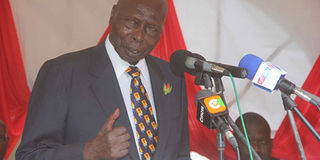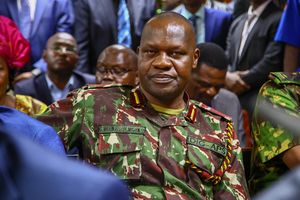Security men with intimate knowledge of President Moi

Retired President Daniel Moi. PHOTO | FILE | NATION MEDIA GROUP
What you need to know:
- In the 24 years he was president, Mr Moi was served by six ADCs who were in military ranks of a Major to a Lieutenant-Colonel.
- In October 1981, the ADC to Egyptian President Anwar Sadat shielded the leader as bullets were fired at the dais. The ADC died on the spot.
As retired President Daniel Moi’s long-serving bodyguard Senior Superintendent (rtd) Leonard Yator was laid to rest last week, five other men had fond memories of a colleague who was ever there during their stints as Aide-de-Camp (ADC) to the former President.
They are Major General (rtd) Peter Ikenye, Brigadier (rtd) Wilson Boinnet and Brigadier (rtd) Alexander Sitienei.
The other two are Lieutenant-General (rtd) Jonathan Rono and Brigadier (rtd) Kimei Kipng’etich.
Missing in the distinguished list of six is Brigadier Samuel Macharia, who passed away last year.
Aide-de-Camp (ADC) is the military term for an officer assigned as aide to a more senior officer.
HUMAN SHIELD
In this case, the ADCs were attached to President Moi in his capacity as the Commander in Chief.
An ADC is not a bodyguard in the true sense of the word, and is not even armed. However, if the worst comes to the worst, the ADC is supposed to be the human shield to the commander in chief, literally taking the bullet for the boss.
A real life case was in October 1981 when the ADC to Egyptian President Anwar Sadat shielded the leader as bullets were fired at the dais.
The ADC died on the spot as President Sadat succumbed on the way to hospital.
In the 24 years he was president, Mr Moi was served by six ADCs who were in military ranks of a Major to a Lieutenant-Colonel.
By virtue of their positions, the ADCs have first-hand knowledge of some of the most momentous events in the country’s history.
Brigadier Samuel Macharia
He was President Moi’s first ADC when he came to power in 1978. Moi inherited him from President Jomo Kenyatta.
Brig Macharia was standing at Mzee Kenyatta’s bedside when the President was pronounced dead at State House, Mombasa, in August 1978.
His last duty to the departed Commander in Chief was as one of the officers who pulled the gun-carriage carrying the casket of the President from State House, Nairobi, to the mausoleum at Parliament buildings.
Later, he and the procession commander, Lieutenant Joseph Musomba, handed over the neatly folded President Kenyatta’s C in C (commander in chief) uniform to widow Mama Ngina to keep as memorabilia.
Brigadier Macharia would resume his duty two months later when acting President Moi was duly elected and sworn in.
Major-General Peter Ikenye
He took over from Brigadier Macharia in late 1979. On many a day, the ADC would be helping the President lift up heavy boulders to construct gabions in soil conservation drives.
He accompanied the new President on many visits abroad, including the chaotic trip to Libya in 1982.
He was also with the President on the night of the attempted military coup and, for only the first time, he would put on military fatigues and arm himself with a sub-machine gun to protect the C in C.
On leaving State House, he was promoted to a brigadier and appointed commandant at the Kahawa Army Barracks.
He rose to the rank of Major General and headed the Eastern Command of the Kenya Defence Forces.
On retirement, he was picked to chair a presidential task force on the protection of forests. He comes from a military family.
His nephew, Maj Gen Andrew Ikenye, is today the commandant at the National Defence College.
Brigadier Wilson Boinnet
He was picked from the military intelligence corps not long after the attempted military coup. The coup had made President Moi paranoid.
He was one of two ADCs who served the retired president the longest stint of eight years.
Moi trusted the ADC as the only person who could tell him the truth, however unpleasant.
Distaste for intrigue would cost the ADC his job after a quarrel with powerful Cabinet minister Nicholas Biwott during a presidential trip abroad.
He would pay for it with demotion to the less glamorous job of a military attaché in Zambia.
In 1996, Moi recalled him from career Siberia and appointed him head of the Directorate of Security Intelligence, then a department of the Kenya Police.
It is during Boinnet’s tenure that the Directorate of Security Intelligence was converted to the autonomous National Security Intelligence Services (NSIS), a more professional entity unlike its precursor which was synonymous with rogue activities.
Boinnet nearly lost his job for persistently telling President Moi that Mr Uhuru Kenyatta wouldn’t win the 2002 presidential election.
He fell foul of the Kibaki administration for advising against holding of the 2005 referendum on the constitution, which he correctly foretold the government side would lose.
Brigadier Alex Sitienei
He was appointed ADC in the tenure of General Daudi Tonje as the chief of the Defence Forces.
Before his appointment as ADC, Sitienei, a Bachelor of Education and postgraduate journalism diploma holder, was head of education programmes at Defence headquarters.
As ADC to the president, he retained the intellectual edge and would often write the presidential speeches.
On retirement, he tried his hand in politics and unsuccessfully contested Sotik parliamentary seat.
Lieutenant General Jonathan Rono
He took over from Sitienei in 1998. The ADC was to witness first-hand how politics work when, in the morning of March 18, 2002, President Moi had tea with Vice-President George Saitoti and Cabinet minister Joseph Kamotho and told them with a straight face that their names were in the list of the proposed contestants for Kanu vice-chairman and secretary-general, respectively, at the elections to be held at Kasarani.
Yet only seconds before they were ushered in, the President had given the ADC a list that had no Saitoti or Kamotho.
After State House, Rono would be appointed commandant of the Eastern Command of the Kenya Defence Forces.
In 2014 he relocated to Somalia as deputy and later commander of the African Union Mission in Somalia (Amisom). He has since retired from the military.
Brigadier Kemei Kipng’etich
He was the last of Moi’s ADCs, serving in the last six and most eventful months of the Kanu administration.
Early in December 2002, he accompanied President Moi on his last presidential trip abroad.
By then the President had ceased to be in denial and had accepted the opposition was headed for victory.
On the way from Washington, Moi visited opposition candidate Kibaki and running mate Michael Wamalwa, who were recuperating in a London hospital.





